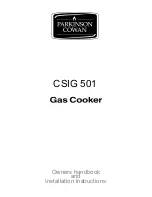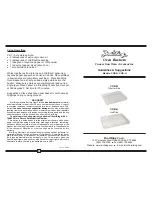
- 6 -
04/2019
Copyright © 2019, Fast ČR, a.s.
EN
Food Dehydrator
User's manual
■
Prior to using this appliance, please read the user's manual thoroughly, even in cases,
when one has already familiarised themselves with previous use of similar types of
appliances. Only use the appliance in the manner described in this user’s manual.
Keep this user's manual in a safe place where it can be easily retrieved for future use.
In the event that you hand this appliance over to somebody else, make sure to also
include this user's manual.
■
We recommend saving the original cardboard box, packaging material, purchase
receipt and responsibility statement of the vendor or warranty card for at least the
duration of the legal liability for unsatisfactory performance or quality. In the event
of transportation, we recommend that you pack the appliance in the original box
from the manufacturer.
■
Carefully unpack the appliance and take care not to throw away any part of the
packaging before you find all the parts of the appliance.
DESCRIPTION OF THE APPLIANCE AND ACCESSORIES
A1
Main switch
A2
Control panel
A3
Cabinet with dehydration area
A4
Slide-out trays
A5
Stainless steel racks
A6
Glazed door
A7
Handle
B1
Temperature control knob
B2
Dehydration temperature
selection guide
B3
Display
B4
Backlit start/pause button
B5
Increase time button (plus)
B6
Decrease time button (plus)
PURPOSE OF USE AND FEATURES OF THE FOOD DEHYDRATOR
■
The food dehydrator is intended for dehydrating food such as fruit, vegetables, fruits
of the forest, meat, seeds, beans, nuts, mushrooms, etc. It is also suitable for drying
herbs, medicinals, spices or even flowers for decorating or for making aromatic
mixtures.
■
The food dehydrator comprises of a cabinet with a drying area with ten levels for
slide-out trays and stainless steel racks. The heating element, motor with fan and
thermostat are located at the back of the cabinet.
■
The food dehydrator functions on the basis of Horizontal Air Flow technology,
which ensures even heat distribution. It enables heat to be evenly distributed to
all levels of the drying area and eliminates the need to rotate the food racks during
the dehydration process.
WHY USE A FOOD DEHYDRATOR?
■
Drying (dehydration) is one of the oldest methods of food preservation during
which food is heated to evaporate its moisture content. Unlike standard long-term
food storage (e.g. canning, freezing), gentle dehydration retains up to 80 % of
vitamins, minerals and trace elements, while concentrating aromatic compounds,
which makes dehydrated foods all the more tasty. With correct storage, it is then
possible to use dehydrated foods all year round.
■
Foods that are heated during standard cooking or canning procedures over a longer
period of time at a temperature higher than 48 °C start to lose their nutritional
value and enzyme content. Food enzymes are important because they aid the
body's digestive enzymes in breaking up food into digestible proteins. A suitable
food dehydrator such as this one, is able to maintain a sufficiently low temperature
at which enzymes do not lose their effect, while at the same time generate
sufficiently hot air for fast dehydration of food and prevent the development of
moulds and bacteria.
BEFORE FIRST USE
■
Before first using the food dehydrator, thoroughly wash the slide-out trays and
stainless steel racks in hot water using neutral kitchen detergent. Then rinse all these
parts with clean water and dry them thoroughly with a fine wiping cloth.
■
Also clean out the inside of the cabinet using a lightly dampened wiping cloth
and then wipe everything dry. When cleaning, take care not to wet the heating
elements or the fan of the food dehydrator. Never submerge the cabinet of the food
dehydrator in water or any other liquid.
■
Before first use, we recommend running the food dehydrator empty for at least 4
hours. After turning off the food dehydrator, allow it and all its accessories to cool
down and air out to rid them of potential odours.
PREPARING FOR OPERATION
LOCATION OF THE FOOD DEHYDRATOR
■
Locate the food dehydrator in a well-ventilated, warm and dry room with minimal
dustiness. To ensure proper air circulation, there must be a clearance of at least 15
cm around to the food dehydrator.
■
The surface on which the food dehydrator is placed must be stable, heat resistant
and sufficiently far from other sources of heat. The load bearing capacity of the
selected surface must correspond to the combined weight of your food dehydrator
and its contents.
■
Also select a location respecting the fact that it is not appropriate to move the food
dehydrator while it is running. Likewise, also take into consideration the fact that the
aroma of the dehydrated food will be released into the room during the dehydration
process, which may not be pleasant for everyone.
SELECTING APPROPRIATE FOODS
■
Correctly selecting and preparing foods for dehydration will result in their better
appearance and taste, faster drying and termination of the ripening process, and it
will also extend the food's shelf life.
■
The best results are only achieved when good quality ingredients are used.
Practically any type of fruit or vegetable may be dehydrated. Only select ripe fruits
and vegetables, not over-ripened, and free of bruising, rot and moulds. It is possible
to dehydrate sour and mildly sweet fruits and vegetables.
■
When intending to dehydrate meat, it must be fresh and lean.
PREPARING INGREDIENTS
Note:
It is highly probable that fruits and vegetables bought in ordinary stores
are waxed or treated with a spray. Most sprays or waxes can be washed off
using bio-degradable cleaning products or in vinegar water, after which it
is necessary to rinse the food using clean water. If the attempt to remove
the wax or spray is unsuccessful, we recommend to peel the food prior to
dehydrating it.
FRUIT
■
Thoroughly wash the fruit and dry it well. Prepare only an amount of fruit that you
will be able to dry within a single cycle. Remove any soft or damaged parts. Remove
any pits, stones, stems or roots, and any other unusable parts.
■
Cut the fruit into pieces of equal thickness, ideally 2 to 4 mm. Pieces of varying
thickness unnecessarily extend the dehydration time. Cutting it into smaller pieces
will speed up the dehydration process, whilst improving the quality of the product.
■
Small fruits such as various types of berries (strawberries, bilberries, cranberries, etc.)
do not need to be cut up. However, larger fruits should be cut in half or cut into
slices or cubes.
■
Dry the cut up fruit using a clean wiping cloth or paper towel.
■
To prevent certain types of fruit from browning (apples, pears or apricots), soak the
fruit slices in a solution made from 250 ml of water and 1 tablespoons of lemon or
pineapple juice prior to dehydrating them. To achieve interesting flavours, you can
put honey, sugar, cinnamon or coconut on it. Then allow the pieces of fruit to drip
off any excess and then they can be immediately dehydrated. Fruit that is treated
with this solution will remain light coloured and will not turn brown during the
dehydration process nor during storage.
■
Fruits with naturally tough peels (grapes, plums or even figs) may be blanched
in boiling water for 1-2 minutes to speed up the dehydration process. Then
immediately submerge them in cold water, cool them down, dry them and cut them
up into slices.
■
Place unpeeled fruit with the peel facing downwards and the cut surface upwards.
Always place non-straight shapes on the edge with the peel, not on the straight
surface.
VEGETABLES
■
Clean the vegetables thoroughly and wash them.
■
Cut out any surface defects.
■
It is advisable to steam vegetables that require long cooking times, e.g. root
vegetables, pea pods, beetroot, broccoli, carrot, celery, corn, potato and cauliflower
prior to dehydrating them. To prevent it from losing colour and vitamins, it is
sufficient to cook the given vegetable over steam for approximately five minutes.
■
It is good to peel tomatoes.
■
Cut up vegetables can be dipped in salty water.
MEAT
■
Beef, game, poultry or fish meat is suitable for dehydration. Select lean meat
containing as little fat as possible. The leaner the meat, the faster it will be
dehydrated. The higher the fat content in the meat, the shorter will be its shelf life
after dehydration.
■
Thoroughly dry the meat and trim off any fatty parts. To ensure even dehydration,
then slice it into very thin strips approximately 2 to 5 mm thick and 2.5 cm wide.
Select the length as required.
■
Season the finished strips according to taste using salt, marinating it, applying
barbecue spices, etc. Leave the seasoned meat to rest, ideally overnight in
a refrigerator.
■
After placing the meat into the food dehydrator, first allow it to heat up to
a temperature of 70°C for 15 minutes, which will destroy potential bacteria and
other harmful substances in the meat. Then lower the temperature as needed and
according to experience, for example 63°C and dehydrate it for approximately 5
to 7 hours. Check on the dehydration process every hour. Well dehydrated meat
is determined by pushing both its ends towards each other and seeing whether it
snaps in the middle.
HERBS, SPICES AND FLOWERS
■
Dehydrate herbs very gently. Only remove the stems, and do not cut them up any
further. Leafy herbs need to be turned over during the dehydration process to
prevent them from sticking.
■
Leaves appropriate for dehydration are young and brittle, harvest pea pods before
they open up. Pick flowers that are young and half-opened.
PET FOOD SNACKS
■
To make snacks for household pets, use healthy and fresh ingredients free of any
additives or preservatives. It is important to take into consideration the size of
the animal. For example, small dog breeds have small mouths and tiny teeth and
need small snacks that are not too crunchy. On the other hand, large dog breeds
can handle big and crunchy snacks. You can test their hardness by crushing a few
snacks in your hand.

























